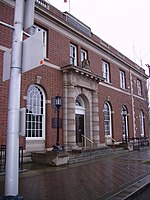Port Angeles High School
Education in Clallam County, WashingtonHigh schools in Clallam County, WashingtonPort Angeles, WashingtonPublic high schools in Washington (state)

Port Angeles High School (PAHS) is a public high school in Port Angeles, Washington, United States, and is part of the Port Angeles School District. It is the largest high school in the North Olympic Peninsula region. Built in 1953, the facilities are located on 33 acres within a block of Olympic National Park borders. The school has views of the Olympic Mountain Range and the Salish Sea from the campus buildings. The school's mascot is the Roughriders, depicting Theodore Roosevelt on a horse in his role as commander of the First U.S. Volunteer Cavalry. The school's colors are green and white.
Excerpt from the Wikipedia article Port Angeles High School (License: CC BY-SA 3.0, Authors, Images).Port Angeles High School
East Park Avenue,
Geographical coordinates (GPS) Address Nearby Places Show on map
Geographical coordinates (GPS)
| Latitude | Longitude |
|---|---|
| N 48.10083333 ° | E -123.44083333 ° |
Address
Port Angeles High school
East Park Avenue 304
98362
Washington, United States
Open on Google Maps








